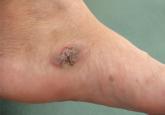Article

Cutaneous Alternariosis in a Renal Transplant Recipient
Alternariosis is a fungal infection that is usually described in immunocompromised patients. We report a case of cutaneous alternariosis in a...
Paraskevi Chatzikokkinou, MD; Roberto Luzzati, MD; Konstantinos Sotiropoulos, MD;
Andreas Katsambas, MD; Giusto Trevisan, MD
Drs. Chatzikokkinou, Luzzati, and Trevisan are from the University Hospital of Trieste, Ospedale Maggiore, Italy. Drs. Chatzikokkinou and Trevisan are from the Department of Dermatology and Venereology and Dr. Luzzati is from the Infectious Diseases Unit. Dr. Sotiropoulos is from the Second Department of Internal Medicine–Propaedeutic, Athens University Medical School, Attikon University Hospital, Greece. Dr. Katsambas is from the Department of Dermatology and Venereology, School of Medicine, National and Kapodistrian University of Athens, Andreas Syggros Hospital.
The authors report no conflict of interest.
Correspondence: Paraskevi Chatzikokkinou, Department of Dermatology and Venereology, University Hospital of Trieste, Ospedale Maggiore, Via Stuparich 1, I-34100 Trieste, Italy (chatzikokkinouparaskevi@hotmail.com).

Immunosuppression associated with treatment following renal transplantation was the primary cause of M chelonae infection in our patient, as has previously been reported in the literature.3-4 This was further supported by the lack of prior trauma or invasive procedure (eg, mesotherapy) in the affected areas. Specifically, our patient had more than 5 lesions on the lower legs; in accordance with a previous comprehensive study,1 the presence of more than 5 lesions indicates a disseminated cutaneous infection, which usually is correlated with immunosuppression (such as in our patient). Localized infections generally are observed in immunocompetent hosts.1
The exact pathogenetic mechanism of M chelonae infection in our patient is not clear. In patients with suppressed immunity, the variable clinical presentation of infection with NTM often impedes diagnosis. Cutaneous M chelonae lesions may be mistakenly diagnosed as Kaposi sarcoma or rarely as pyoderma gangrenosum. The differential diagnosis of subcutaneous nodules includes histoplasmosis, cryptococcosis, blastomycosis, coccidioidomycosis, nocardiosis, mycetoma, sporotrichosis, actinomycosis, and tuberculosis. In our patient, approximately 2 months elapsed between presentation of symptoms and definitive diagnosis, which was less than that reported in previously published cases.2,7-9
Histology and tissue culture followed by proper genetic analysis remains the gold standard for diagnosing NTM infection.10,11 In the interest of patients, time-consuming biochemical analyses should be replaced by molecular genetic diagnostic strip tests, which are fast, exact, and available in commercial kits for both common mycobacteria and additional species.12
Once the diagnosis of NTM infection has been established, sensitivity testing is mandatory to guide targeted therapy; however, clinicians should bear in mind that susceptibility testing does not guarantee clinical success, as correlations of susceptibility testing and clinical response have not been assessed.8 Standard antituberculous drugs (eg, isoniazid, rifampin, pyrazinamide) have no role in the treatment of M chelonae infection. The first-line antibiotics are clarithromycin, tobramycin, and linezolid, followed by imipenem, amikacin, clofazimine, doxycycline, and ciprofloxacin.10 Optimal outcomes have been reported in patients treated both with antibiotics and with surgical debridement. Although monotherapy with quinolones is not recommended for treatment of infection with NTM due to the high risk of mutational resistance, our patient received long-term antibiotic treatment with ciprofloxacin over a 6-month period and showed no recurrence at 24-month follow-up.
Conclusion
Clinicians who treat patients with chronic skin or soft tissue infections should consider infection with NTM in the differential diagnosis, particularly in patients with suppressed immunity, but also in immunocompetent patients following any invasive procedure. Detailed medical history and skin biopsy followed by histology and culture are recommended for the diagnosis. Infection with NTM requires rapid action. Sensitivity testing is necessary in choosing an effective treatment. New molecular genetic diagnostic strip tests can differentiate species of NTM sooner than biochemical analyses, thereby helping clinicians initiate appropriate antimicrobial treatment in a timely fashion.

Alternariosis is a fungal infection that is usually described in immunocompromised patients. We report a case of cutaneous alternariosis in a...
